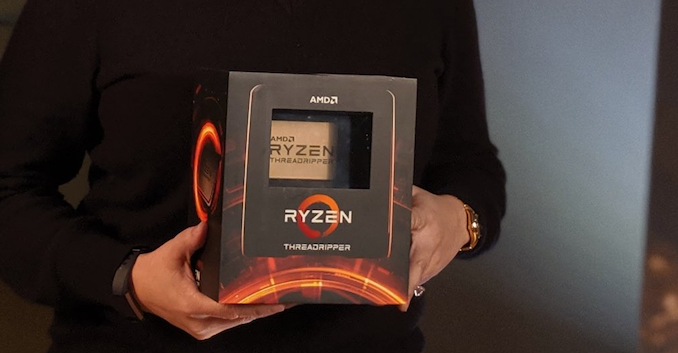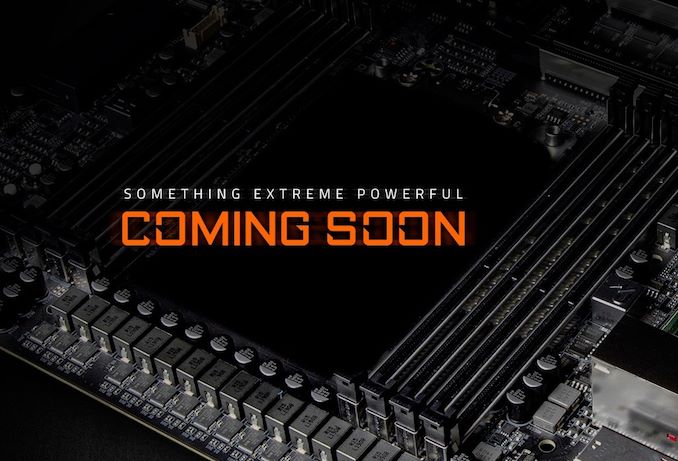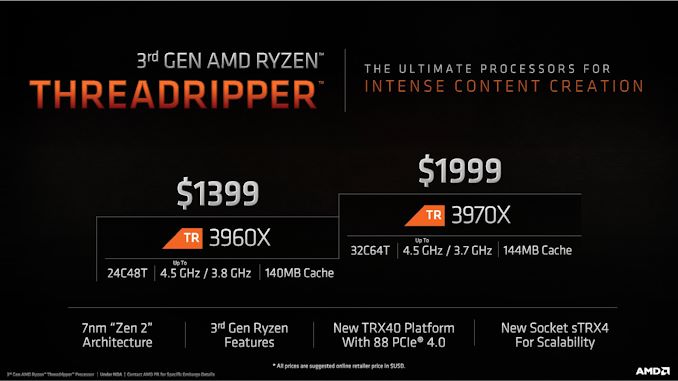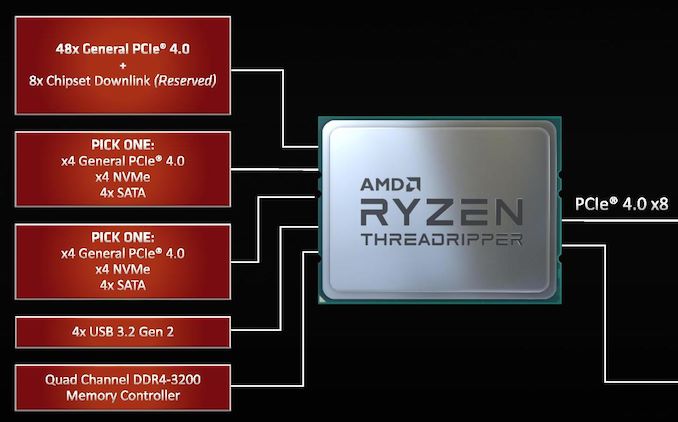AMD Q4: 16-core Ryzen 9 3950X, Threadripper Up To 32-Core 3970X, Coming November 25th
by Dr. Ian Cutress on November 7, 2019 9:00 AM EST3rd Gen Ryzen Threadripper, Up to 32-Cores
It’s the product a lot of users have been waiting for. Ever since AMD introduced the world to its Rome processors, with up to 64 cores based on 7nm chiplets and the Zen 2 microarchitecture, rumors have been swirling about what exactly the corresponding Threadripper platform will bring. We now have the answers to your questions.

From CEO Dr. Lisa Su's Twitter
The two processors that AMD will be initially launching in the 3rd Generation Ryzen Threadripper family are the TR 3960X and the TR 3970X. These are 24-core and 32-core parts respectively, built using four chiplets and one IO die in a Rome-sized package. Both CPUs will feature a 280 W TDP, and offer boost frequencies up to 4.5 GHz.
| AMD HEDT SKUs | |||||||
| Cores/ Threads |
Base/ Turbo |
L3 | DRAM 1DPC |
PCIe | TDP | SRP | |
| Third Generation Threadripper | |||||||
| TR 3970X | 32 / 64 | 3.7 / 4.5 | 128 MB | 4x3200 | 64 | 280 W | $1999 |
| TR 3960X | 24 / 48 | 3.8 / 4.5 | 128 MB | 4x3200 | 64 | 280 W | $1399 |
| Second Generation Threadripper | |||||||
| TR 2990WX | 32 / 64 | 3.0 / 4.2 | 64 MB | 4x2933 | 64 | 250 W | $1799 |
| TR 2970WX | 24 / 48 | 3.0 / 4.2 | 64 MB | 4x2933 | 64 | 250 W | $1299 |
| TR 2950X | 16 / 32 | 3.5 / 4.4 | 32 MB | 4x2933 | 64 | 180 W | $899 |
| TR 2920X | 12 / 24 | 3.5 / 4.3 | 32 MB | 4x2933 | 64 | 180 W | $649 |
| Ryzen 9 3950X | 16 / 32 | 3.5 / 4.7 | 32 MB | 2x3200 | 24 | 105 W | $749 |
There’s a lot to unpack here.
The 32-core TR 3970X has 64 threads, a base frequency of 3.7 GHz, a turbo frequency of 4.5 GHz, comes with 64 PCIe 4.0 lanes, four memory channels of DDR4-3200 (1DPC), and will retail at $2000. To put that in perspective, it wasn’t too long ago that for that money you would only get 10 cores.
The 24-core TR 3960X offers almost the same, but trades a few cores for a 3.8 GHz base frequency and will retail for $1399. The competition for this part is likely to be the Core i9-10980XE, which has 18-cores and has a tray price of $979.
Both CPUs have 128 MB of L3 cache, due to the use of four chiplets. We asked AMD if these CPUs have 4 chiplets inside the package and 4 dummy ones, like the dummy silicon in previous Threadripper products – AMD confirmed that there will only be four chiplets in each package. This means that each CPU will be in a symmetrical 6+6+6+6 or 8+8+8+8 configuration, minimizing the total amount of silicon AMD has to ship.
Each CPU supports four channels of DDR4-3200. We confirmed that this included support for ECC UDIMMs on a board-by-board basis, but does not include RDIMM or LRDIMM support. AMD did state that these new CPUs are validated for the 32 GB DDR4 modules coming onto the market, which makes a realistic maximum DRAM support of 256GB (8 x 32GB).
For performance, AMD gave us some numbers comparing each CPU to the 18-core Core i9-9980XE from Intel. In common workstation tasks, such as program compilation, Adobe Premier transcoding, and rendering, AMD is quoting a +22-31% performance gain for the 24-core part, and a +36-49% uplift for the 32-core part.
When we asked AMD about AI performance, they stated that while AI is an emerging workload in the enterprise space, for the workstation market these products are targeting exactly what their customers are requesting today: ‘Threadripper and Zen 2 have been taken by customers looking at content creation, CAD, and code work/compilation. AI is still an emerging vertical in the workstation at this time.’
Compared to previous generation Threadripper parts, the new 3rd Gen Ryzen Threadripper features a central I/O die in the hardware which all the chiplets are connected to. This I/O die has all the PCIe lanes and the DRAM channels, which means that the memory latency issues with the 1st/2nd Generation Threadripper should no longer be present with the new chips. Both chips launched here have 64 PCIe 4.0 lanes, which are split into 48x general purpose lanes, 8 lanes for the CPU-to-chipset communications, and 8 lanes for I/O. This means that users can have the following CPU configurations:
- 1st root complex: x16 or x8/x8
- 2nd root complex: x16 or x8/x8
- 3rd root complex: x16 or x8/x8
- Chipset downlink: x8
- Pick one: PCIe 4.0 x4 slot, 1 x NVMe PCIe 4.0 x4, 4x SATA
- Pick one: PCIe 4.0 x4 slot, 1 x NVMe PCIe 4.0 x4, 4x SATA
Obviously things like SATA ports can also come off the chipset. We discuss the new chipset on the next page. But one thing to note here is the CPU-to-chipset connection.
For AMD Ryzen on most AM4 chipsets, for first generation and second generation Threadripper, and for every Intel platform in recent memory, the connection between the CPU and the chipset has been the equivalent of a PCIe 3.0 x4 link. This link, as the industry has progressed into the world of NVMe storage, has become a bottleneck for any user wishing to push a modern PCIe-based storage drive along with anything else on the same uplink. AMD increased it for the X570 motherboard generation to PCIe 4.0 x4 for mainstream, doubling the bandwidth from its closest competitor, but what AMD is doing with the new 3rd Gen Threadripper is increasing that link bandwidth by a factor of two again.
With this CPU, and the TRX40 chipset, users now have a PCIe 4.0 x8 link between the CPU and the chipset. This is the equivalent of a PCIe 3.0 x16 link, or a previous generation full GPU slot. It means that users could, if they wanted, push four times as much data up and down that link. To be honest, this sort of thing should have happened a while go on the Intel side of the equation, so I’m glad that AMD is pushing the boundaries here. It’s also one reason for 3rd Gen Threadripper having a new socket.

From GIGABYTE's Aorus Facebook Page
Yes, you read that correctly: the new Threadripper requires a new socket. Because of the new CPU-to-chipset link, as well as a few ‘forward looking adjustments and scalability’, we now have what AMD are calling an sTRX4 socket and related TRX40 motherboards. AMD wasn’t prepared to make a statement on the record about committing to this socket long term, but stated that adjustments were made to ensure the future longevity of the platform, so one could infer at least one more generation on this new socket. Technically it is the same 4094 pins as the previous socket, and even the keying (the marks along the side of the processor) is the same, however AMD stated that due to this new PCIe 4.0 x8 requirement, if you put a new processor in an old motherboard (or vice versa), it just won’t work.
As for the motherboards, expect a few new parts to enter the market. More details on TRX40 on the next page.
But motherboards aside, I just want to point out that AMD's numbering scheme leaves some room at the top. Above the 3970X, there leaves the potential for a 3980X and 3990X. We know that these CPUs are based on the same layouts as AMD's Rome-based EPYC processors, and those are offered with 48-core and 64-core variants. We may be at a practical TDP limit of 280W, but if there's more room at the top, AMD might take it. At this point, AMD has said that they are only announcing two SKUs today and declined to answer the question of whether any more are coming.
| AMD HEDT SKUs | |||||||
| Cores/ Threads |
Base/ Turbo |
L3 | DRAM 1DPC |
PCIe | TDP | SRP | |
| Third Generation Threadripper | |||||||
| TR3970X + 20 ? | There's some space here for more SKUs | ||||||
| TR3970X + 10 ? | |||||||
| TR 3970X | 32 / 64 | 3.7 / 4.5 | 128 MB | 4x3200 | 64 | 280 W | $1999 |
| TR 3960X | 24 / 48 | 3.8 / 4.5 | 128 MB | 4x3200 | 64 | 280 W | $1399 |












171 Comments
View All Comments
cubesdating - Thursday, December 5, 2019 - link
https://hungrysingles.comhttps://cubesdating.com
https://imhookup.com
https://rompmilf.com
https://dateonlinegirls.com
https://rompgirls.com
https://coitusgirls.com
https://coitusdating.com
https://nichelgbt.com
https://hungrymingles.com
M O B - Thursday, November 7, 2019 - link
Have you read any of the Zen3 reviews? AMD is much more power efficient than Intel. Period.zangheiv - Thursday, November 7, 2019 - link
Woah! hold your horses. Do you trust Intel marketing more? Intel TDP is at non-boosted clock. Boost all cores and exceed TDP and you're voiding warranty essentially.airdrifting - Thursday, November 7, 2019 - link
Why there are always idiots like you spreading false information without even owning the CPU or know the basics of current gen hardware? The boost is done automatically without you doing anything in BIOS, all Intel CPU essentially run boost speed right out of the box, so you are saying everyone voided their warranty for doing nothing at all?eddman - Friday, November 8, 2019 - link
Why do you keep insulting others? Turbo does not void any warranty. Boards are not supposed to boost beyond the intel specced clocks.However, there is a non-spec OEM implemented feature on some boards, usually called MCE (multi-core enhancement). This option would cause the board to boost all-core clocks to the single-core boost clock which does break the spec. Realistically, it shouldn't be enabled out-of-the-box but some board makers apparently don't care. Your beef should be with them, not intel.
Korguz - Friday, November 8, 2019 - link
eddman, why does he keep insulting others ?? cause he is a child, and when proven wrong, or cant prove what he says, this is his only recourse.. maybe it makes himself feel better...Alexvrb - Friday, November 8, 2019 - link
Intel's TDP is a useless figure. Given the nature of competition, AMD is going to increasingly follow suit with their own less-than-useful TDP. With that being said: As of today, Intel's high end chips eat far more power at stock settings, "base" TDP be damned.Lcs006 - Wednesday, November 13, 2019 - link
airdrifting - You are right, if it makes easier to deal with "alternatively gifted".evernessince - Thursday, November 7, 2019 - link
Well let's just get this straight, Intel processors have to clock high just to match a lower clocked AMD processor. Ryzen 3000 series vs Intel 9000 series is proof of that.Second, you don't seem to realize that overclocking does not improve performance per watt. The gains yielded by OCing a 9900K for example to 5.1 GHz are around 3% while power consumption increase by 30%. Simple math tells me performance per watt decreases.
Let's be frank here, Intel is just barely hanging onto the best gaming CPU crown right now but in every other category they loose. It is not even remotely surprising if they loose in a battle of core count, which is what HEDT is, as AMD's architecture is designed to scale.
Korguz - Thursday, November 7, 2019 - link
evernessince imagine how much worse it would be for intel if ryzen 3000 matched intel's current clocks.....